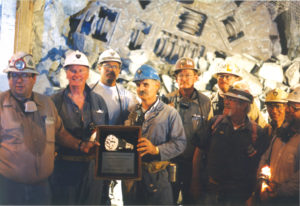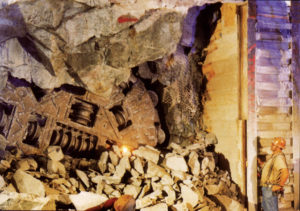![65 Years of Innovation and Experience [default]](https://www.robbinstbm.com/wp-content/uploads/2017/04/Side-Bar-Blue-Blocks_70-Years.jpg)
A Solution for Every Condition: Search our Project Database
Project Map
FEATURED PRODUCT: CROSSOVER MACHINES
Our History
A Legacy of Innovation
Information 24/7
News & Media
Insights in the Industry:
Read the Robbins Blog
 The San Manuel Mine tunnel was developed to extend the life of the mine in Arizona. It is one of the largest underground mines in the world, but projections before the tunnel was built estimated its reserves would be depleted by 1998. The tunnel allowed the development of the Lower Kalamazoo orebody, in the vicinity of dwindling orebodies that had already been tapped.
The San Manuel Mine tunnel was developed to extend the life of the mine in Arizona. It is one of the largest underground mines in the world, but projections before the tunnel was built estimated its reserves would be depleted by 1998. The tunnel allowed the development of the Lower Kalamazoo orebody, in the vicinity of dwindling orebodies that had already been tapped.
The project owner, Magma Copper Company, awarded the construction contract to a joint venture of Frontier-Kemper Constructors Inc. and Deilmann-Haniel GmbH. The joint venture chose a 4.6 m (15.1 ft) Main Beam Robbins TBM to bore the mining tunnel.
The Lower Kalamazoo geology is quite complex, consisting of orebodies, porphyry, and granodiorite. The tunnel route includes numerous faults and dikes — it passed through the San Manuel fault six times and the Virgin Fault five times. Much of the rock had been weakened by hydrothermal metamorphosis.
Robbins designed the new hard rock Main Beam TBM specifically for the geological conditions. The 4.6 m (15.1 ft) diameter cutterhead could reverse rotational direction to prevent jamming when it encountered fractured rock. The machine also featured thirty-three 17 inch (432 mm) backloading disc cutters for greater safety.
The TBM had an installed power of 1,260 kW (1,690 hp) and could generate a cutterhead thrust of 8,558 kN (1,924,000 lb). A torque of 2,969,911 N-m (2,190,494 lb-ft) could also be reached.
Additions to the TBM included roof drill fixtures, and a ring beam erector.
The back-up system extended 120 m (394 ft) on 16 rail-mounted desks behind the TBM. The unit housed electrical supply and control systems, the hydraulic power pack, and auxiliary equipment.
Muck was loaded onto a back-up conveyor and then transported by three trains of muck cars. The track also included a California switch.
 Boring began on November 11, 1993 in a specially prepared concrete chamber. There were no major problems crossing the San Manuel Fault, but wet clay at the Virgin Fault resulted in slow boring. The TBM continued to encounter soft clay and crumbling ground.
Boring began on November 11, 1993 in a specially prepared concrete chamber. There were no major problems crossing the San Manuel Fault, but wet clay at the Virgin Fault resulted in slow boring. The TBM continued to encounter soft clay and crumbling ground.
Robbins and the contractors added several features to the machine to optimize performance. They increased muck flow through the cutterhead, increased cutterhead torque, and added additional rock support to the tunnel. After the initial modifications, TBM performance greatly improved. Daily advances tripled to 22.94 m (75.3 ft) per day for the first 15 months of boring and the machine averaged more than 30 m (98.5 ft) per day for the rest of the project.
The TBM stayed on schedule and holed through on December 4, 1995.

 Close
Close